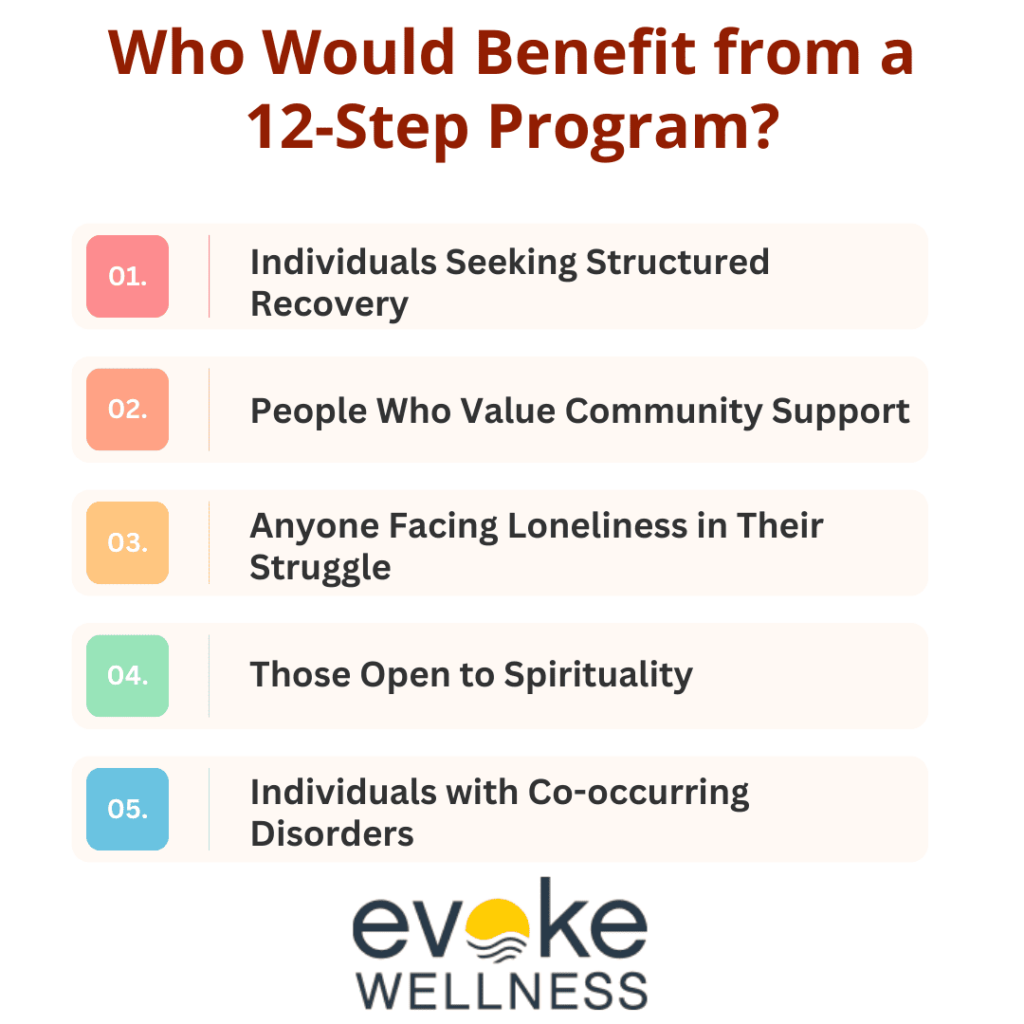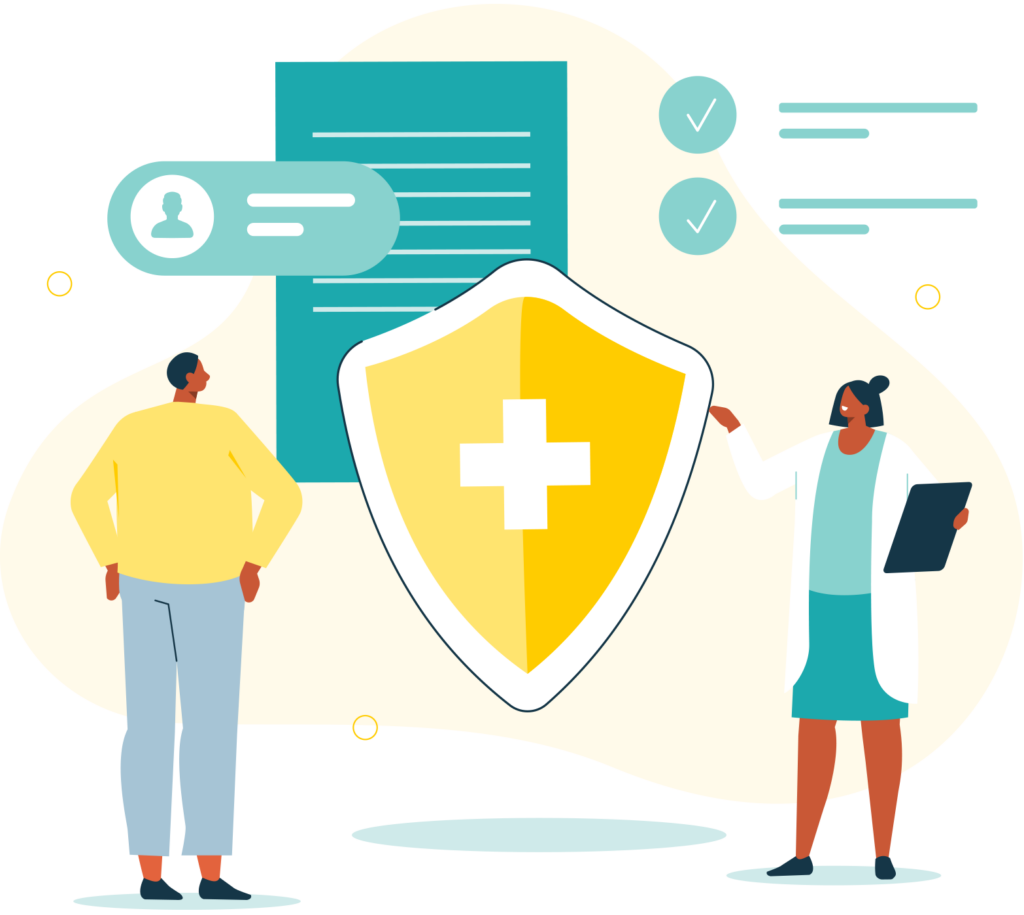The Twelve Step Program, first introduced by Alcoholics Anonymous (AA), has become a foundational approach in many addiction treatment settings. The program offers a structured framework that helps individuals struggling with addiction to overcome their dependence and embark on a path toward recovery. While originally developed for alcohol addiction, the Twelve Steps have been adapted for various types of substance use disorders and are frequently used in Substance Abuse Treatment Programs and Addiction Treatment Centers.
Together, let’s embrace the journey to recovery and the promise of a new beginning. Call us at (833) 503-0734 today or reach out online.
The Role of the Twelve Steps in Addiction Recovery
The Twelve Steps offer more than just a set of principles; they provide a roadmap for personal transformation. By guiding individuals through a process of self-reflection, accountability, and spiritual growth, the program empowers them to take responsibility for their lives. This model has been integrated into numerous Addiction Treatment Programs across the country, including those at Evoke Wellness at San Marcos. Whether an individual is participating in a Cognitive-Behavioral Therapy, Dialectical Behavior Therapy, or a Dual Diagnosis Treatment Program, the Twelve Steps can be a vital tool for long-term recovery.
Why Does a 12-Step Treatment Program Work?
The 12-Step treatment program has been proven effective for many individuals struggling with addiction due to several key factors:
- Structured Framework: The program provides a clear and structured approach to recovery, which can be especially helpful for those who may feel overwhelmed by their addiction. Each step builds upon the previous one, guiding individuals through a comprehensive process of self-reflection and personal growth.
- Sense of Community: The 12-Step program fosters a strong sense of community among participants. Individuals meet regularly in group settings, providing mutual support and encouragement. This social aspect is crucial, as it helps combat the isolation often felt by those dealing with addiction.
- Accountability: Participants in the program learn to take personal responsibility for their actions and decisions. The accountability that comes from sharing experiences with peers and sponsors can motivate individuals to stay committed to their recovery journey.
- Spiritual Component: The inclusion of a spiritual element—whether through belief in a higher power or personal reflection—helps many individuals find purpose and hope. This aspect can be particularly beneficial for those who may feel lost or hopeless in their addiction.
- Proven Success: Numerous studies have shown that the 12-Step program effectively promotes long-term sobriety. Many addiction treatment centers incorporate this approach because it has stood the test of time and demonstrated positive outcomes for countless individuals.
Breaking Down the Twelve Steps
Here’s a detailed breakdown of each of the Twelve Steps, explaining their significance in recovery and how they are used in treatment programs.
Step 1: Admitting Powerlessness Over Addiction
The first step is the foundation of recovery. It involves acknowledging that addiction has made life unmanageable and that help is needed. This act of surrender is often the hardest for individuals because it requires admitting that their willpower alone is not enough. Many people enter Addiction Treatment Programs when they reach this point, as it marks the beginning of their recovery journey.
Step 2: Believing in a Power Greater Than Ourselves
In Step 2, individuals are encouraged to find hope by believing in a power greater than themselves that can help restore their sanity. This higher power can be interpreted in various ways, depending on the individual’s beliefs. For some, it may be a traditional religious concept, while for others, it could be the collective strength of a supportive group or the professional guidance found in an Addiction Treatment Center.
Step 3: Turning Over to a Higher Power
Step 3 involves a conscious decision to turn one’s life over to that higher power. In addiction recovery, this is about letting go of self-destructive behaviors and embracing a structured plan for recovery. Many treatment centers, including Evoke Wellness at San Marcos, emphasize structured care plans that incorporate therapy and counseling, such as a Cognitive-Behavioral Therapy Program or a Dialectical Behavior Therapy Program, to help individuals navigate this step.
Step 4: Taking a Moral Inventory
A significant part of the recovery process is self-reflection. Step 4 requires individuals to take a deep and fearless personal inventory. This is where individuals identify the behaviors and patterns that have contributed to their addiction. In Group Therapy Programs, sharing this inventory with others often helps individuals gain new insights and realize that they are not alone in their struggles.
Step 5: Admitting Wrongs to Others
In Step 5, individuals admit their wrongdoings to another person. This step is about accountability and breaking the silence that addiction often thrives in. Those participating in Family Therapy Programs may find this step particularly beneficial, as it helps to rebuild trust with loved ones who have been affected by their addiction.
Step 6: Becoming Ready for Change
After admitting their wrongdoings, individuals must become willing to let go of their shortcomings. This step is crucial for inner transformation, and it is often during this phase that individuals begin to see the need for professional help. At Evoke Wellness at San Marcos, individuals in Dual Diagnosis Treatment Programs work on addressing both their addiction and any underlying mental health disorders that may have contributed to their substance use.
Step 7: Asking for the Removal of Shortcomings
Humility is at the heart of Step 7. This step is about asking for help to remove the flaws that have fueled the addiction. For many, it’s about seeking the support of treatment programs that provide evidence-based therapy, such as Cognitive-Behavioral Therapy and Dialectical Behavior Therapy, to foster personal growth.
Step 8: Making a List of Those Harmed
In Step 8, individuals begin to make a list of people they have harmed during their addiction. This step is about preparation, as it allows individuals to reflect on their actions and make amends. In Group Therapy Programs, discussing this list can provide a sense of community and reduce feelings of isolation.
Step 9: Making Amends
This step involves taking action to make amends for past wrongs. It’s a critical step in healing relationships that have been damaged by addiction. For individuals in Family Therapy Programs, making amends can be a powerful way to rebuild broken family ties and move forward with recovery.
Step 10: Ongoing Personal Inventory
Recovery is not a one-time event but an ongoing process. Step 10 encourages individuals to continue taking personal inventory and promptly admit when they are wrong. This step is crucial in maintaining long-term sobriety and preventing relapse. In Addiction Treatment Centers, relapse prevention strategies are often taught as part of the treatment plan.
Step 11: Seeking Spiritual Growth
Step 11 is about deepening one’s spiritual connection, whether through prayer, meditation, or mindfulness practices. At Evoke Wellness at San Marcos, individuals are encouraged to explore practices that promote mental and emotional well-being as part of their treatment, such as mindfulness and stress management techniques in Addiction Therapy Programs.
Step 12: Helping Others in Recovery
In the final step, individuals are encouraged to share their recovery journey with others, helping those who are still struggling with addiction. This act of service helps maintain sobriety and fosters a sense of purpose. Many people who complete the Twelve Step Program go on to become sponsors or volunteers, helping others in Substance Abuse Treatment Programs.
Who Would Benefit from a 12-Step Program?
A 12-Step program can benefit a wide range of individuals struggling with substance use disorders and behavioral addictions, including:
- Individuals Seeking Structured Recovery: Those looking for a clear path to recovery often find the systematic approach of the 12 Steps helpful. It can guide them through the complexities of addiction and recovery.
- People Who Value Community Support: Individuals who thrive in group settings and appreciate shared experiences will benefit from the fellowship found in 12-Step meetings. This program is designed for those who can connect with others who share similar struggles.
- Anyone Facing Loneliness in Their Struggle: For individuals feeling isolated due to their addiction, the 12-Step program offers a sense of belonging. Participants learn they are not alone in their struggles, which can be incredibly comforting.
- Those Open to Spirituality: While the 12-Step program can be adapted to fit various beliefs, those who are open to exploring a spiritual aspect of recovery may find it particularly resonant.
- Individuals with Co-occurring Disorders: Those struggling with both substance use and mental health issues may also benefit from the 12-Step program, especially when integrated with other therapeutic approaches, such as Dual Diagnosis Treatment Programs.
What Can I Expect During a 12-Step Program?
When entering a 12-Step program, participants can expect the following:
- Initial Assessment: Individuals typically begin with an assessment to determine their needs and goals. This may involve discussions about their substance use history, mental health, and treatment preferences.
- Regular Meetings: Participants will attend regular meetings, which can vary in frequency from daily to weekly. Meetings often consist of group discussions, sharing personal experiences, and reading materials related to the steps.
- Sponsorship: Many participants will be encouraged to find a sponsor—an experienced member of the program who can provide guidance and support throughout the recovery process. This relationship is crucial for accountability and motivation.
- Step Work: Participants will work through the Twelve Steps at their own pace, often with guidance from their sponsor and support group. This step work may involve self-reflection, journaling, and discussions about personal challenges.
- Integration with Other Therapies: A 12-Step program can be integrated with other therapeutic modalities, such as Cognitive-Behavioral Therapy and Dialectical Behavior Therapy, to address underlying issues and provide a comprehensive approach to recovery.
- Focus on Service: As participants progress through the program, they will be encouraged to help others in recovery, reinforcing their commitment to sobriety and fostering a sense of purpose.
The Role of Therapy in Facilitating the Twelve Steps
Therapy plays a crucial role in helping individuals navigate the Twelve Steps. Programs like Cognitive-Behavioral Therapy (CBT) and Dialectical Behavior Therapy (DBT) are often integrated into Twelve Step work to help individuals recognize and challenge the negative thought patterns that contribute to addiction. These therapies provide the tools individuals need to work through the steps and maintain long-term sobriety.
How Long Does a 12-Step Program Take to Complete?
The duration of a 12-Step program varies widely based on individual needs and circumstances:
- Ongoing Nature: The 12-Step program is designed to be an ongoing process rather than a fixed duration. Many individuals participate in meetings and continue to work through the steps even after achieving sobriety, as it is a lifelong commitment to personal growth and recovery.
- Individual Pace: Each person progresses through the steps at their own pace. Some may complete the steps within a few months, while others might take years to fully embrace and integrate the principles into their lives.
- Program Integration: If the 12-Step program is part of a broader treatment plan, such as Substance Abuse Treatment Programs or Addiction Treatment Programs, the overall duration may be influenced by the individual’s progress in other therapeutic areas.
- Continued Support: Even after completing the formal steps, individuals are encouraged to remain involved in the community through ongoing meetings and support, reinforcing their recovery and helping others along the way.
Conclusion: Integrating the Twelve Steps into Treatment
The Twelve Step Program is a powerful tool for individuals recovering from addiction, offering a framework for personal growth, healing, and long-term sobriety. At Evoke Wellness at San Marcos, we incorporate the Twelve Steps into a broader treatment approach that includes Addiction Treatment Programs, Dual Diagnosis Treatment Programs, and evidence-based therapies such as Cognitive-Behavioral Therapy and Dialectical Behavior Therapy. By combining the Twelve Steps with professional treatment, individuals have the best chance for lasting recovery. Together, let’s embrace the journey to recovery and the promise of a new beginning. Call us at (833) 503-0734 today or reach out online.
FAQ on What Are the Twelve Steps in the Twelve Step Program?
What are the Twelve Steps in the Twelve Step Program?
The Twelve Steps are a set of guiding principles for recovery from addiction and other behavioral issues. They include steps like admitting powerlessness over the addiction, seeking help from a higher power, making amends for past wrongs, and helping others.
How does the Twelve Step Program work?
The program works through a combination of self-reflection, accountability, group support, and spiritual growth. Participants meet regularly to share their experiences and work through the steps, often with the guidance of a sponsor.
Who can benefit from a Twelve Step Program?
Individuals struggling with substance use disorders, those seeking a structured recovery path, and those looking for community support can benefit from the Twelve Step Program. It can also be beneficial for those with co-occurring mental health disorders.
How long does it take to complete the Twelve Step Program?
There is no fixed duration for the Twelve Step Program. Participants work through the steps at their own pace, and many continue to engage with the program long after completing the steps as part of their ongoing recovery.
Can the Twelve Step Program be integrated with other therapies?
Yes, the Twelve Step Program can be integrated with other therapeutic approaches, such as Cognitive-Behavioral Therapy and Dialectical Behavior Therapy, to provide a comprehensive treatment plan that addresses both addiction and underlying mental health issues.



